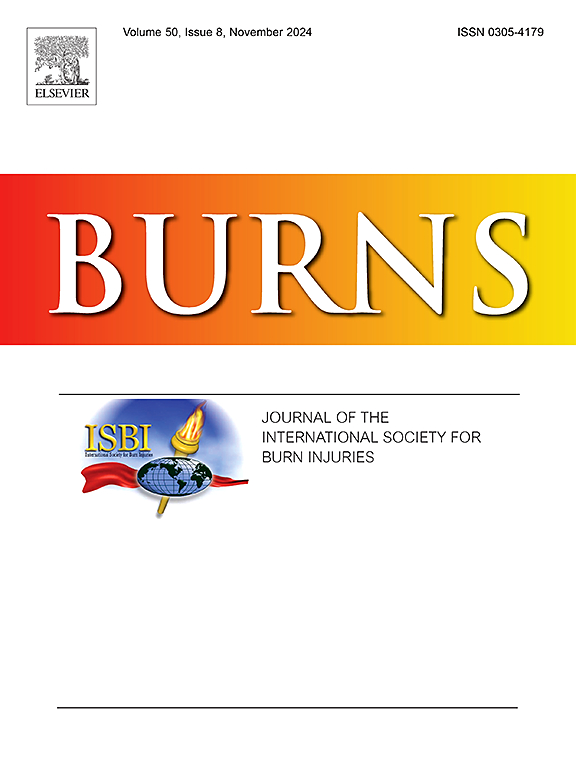Nile tilapia skin in burn wound healing: A scoping review
IF 2.9
3区 医学
Q2 CRITICAL CARE MEDICINE
引用次数: 0
Abstract
Burn wound management involves complex phases, with wound closure crucial for reducing mortality risk and achieving functional recovery. Though effective, traditional methods like skin grafting face limitations in extensive burns. Nile tilapia skin (NTS) has emerged as a promising alternative due to its high collagen content, biocompatibility, and moisture retention properties. A scoping review was conducted using EMBASE, Medline, and Cochrane Library databases. Inclusion criteria targeted studies using NTS in burn wound management across human and animal models. Outcomes analyzed included healing time, protein or gene expression changes, and cell proliferation. Articles were systematically screened and narratively synthesized. Of the 1035 articles retrieved, 13 met the inclusion criteria. Small-scale studies demonstrated that NTS accelerates wound healing, enhances re-epithelialization, and reduces pain compared to conventional treatments. Clinical trials highlighted faster recovery, decreased analgesic use, and fewer dressing changes in NTS-treated burns. However, these trials have marked limitations due to small study sample sizes, variability in application methods, and limited long-term outcome data. Mechanistically, NTS promotes cell migration, modulates inflammatory responses, and enhances angiogenesis. Its biocompatibility and antimicrobial properties further support its use. NTS represents a cost-effective, accessible alternative for burn wound management. However, standardizing protocols and conducting larger trials are essential for broader adoption. Addressing current treatment gaps can improve outcomes, particularly in low-resource environments. Further research is needed to standardize its use and optimize its therapeutic impact.
尼罗罗非鱼皮在烧伤创面愈合中的应用综述
烧伤创面管理涉及复杂阶段,创面闭合对于降低死亡风险和实现功能恢复至关重要。虽然有效,但像皮肤移植这样的传统方法在大面积烧伤中面临局限性。尼罗罗非鱼皮(NTS)因其高胶原蛋白含量、生物相容性和保湿性而成为一种有前途的替代品。使用EMBASE、Medline和Cochrane图书馆数据库进行范围审查。纳入标准针对的是在人类和动物模型中使用NTS进行烧伤创面管理的研究。结果分析包括愈合时间、蛋白质或基因表达变化和细胞增殖。文章被系统地筛选和叙述合成。在检索到的1035篇文章中,有13篇符合纳入标准。小规模研究表明,与传统治疗相比,NTS可以加速伤口愈合,增强再上皮化,减轻疼痛。临床试验强调nts治疗烧伤恢复更快,镇痛药使用减少,换药次数减少。然而,由于研究样本量小、应用方法的可变性和有限的长期结果数据,这些试验有明显的局限性。在机制上,NTS促进细胞迁移,调节炎症反应,并促进血管生成。其生物相容性和抗菌性能进一步支持其使用。NTS是一种具有成本效益,可获得的烧伤创面管理替代方案。然而,标准化协议和进行更大规模的试验对于更广泛的采用至关重要。解决目前的治疗差距可以改善结果,特别是在资源匮乏的环境中。需要进一步的研究来规范其使用并优化其治疗效果。
本文章由计算机程序翻译,如有差异,请以英文原文为准。
求助全文
约1分钟内获得全文
求助全文
来源期刊

Burns
医学-皮肤病学
CiteScore
4.50
自引率
18.50%
发文量
304
审稿时长
72 days
期刊介绍:
Burns aims to foster the exchange of information among all engaged in preventing and treating the effects of burns. The journal focuses on clinical, scientific and social aspects of these injuries and covers the prevention of the injury, the epidemiology of such injuries and all aspects of treatment including development of new techniques and technologies and verification of existing ones. Regular features include clinical and scientific papers, state of the art reviews and descriptions of burn-care in practice.
Topics covered by Burns include: the effects of smoke on man and animals, their tissues and cells; the responses to and treatment of patients and animals with chemical injuries to the skin; the biological and clinical effects of cold injuries; surgical techniques which are, or may be relevant to the treatment of burned patients during the acute or reconstructive phase following injury; well controlled laboratory studies of the effectiveness of anti-microbial agents on infection and new materials on scarring and healing; inflammatory responses to injury, effectiveness of related agents and other compounds used to modify the physiological and cellular responses to the injury; experimental studies of burns and the outcome of burn wound healing; regenerative medicine concerning the skin.
 求助内容:
求助内容: 应助结果提醒方式:
应助结果提醒方式:


